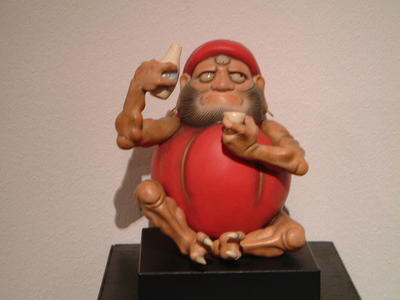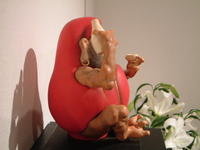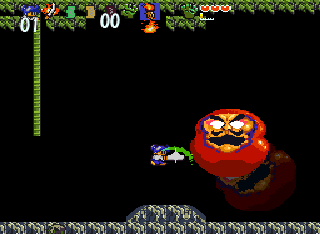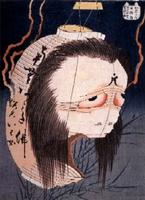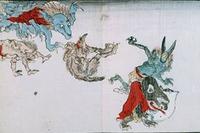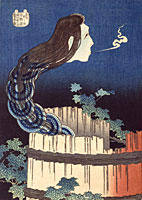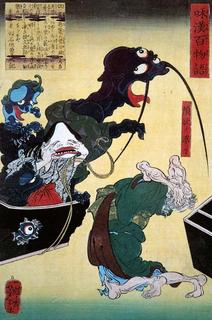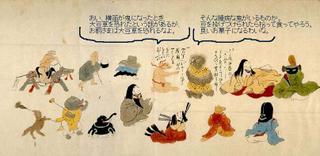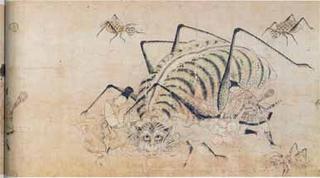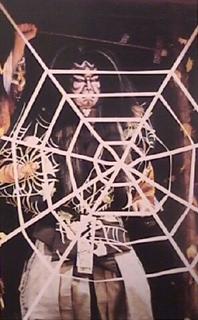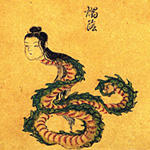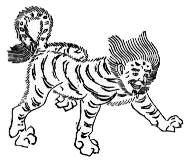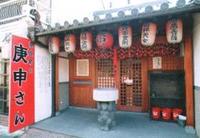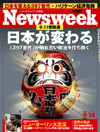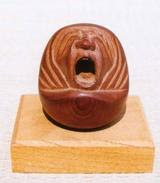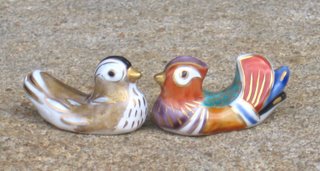. Komuso begging monks 虚無僧 .
:::::::::::::::::::::::::::::::::::::::::::::::::::::::::::::::::::::::::::::::::::::::::::::::::::::
Shakuhachi, the Bamboo Flute
bamboo flute -
the blind monk plays
with the autumn winds
and Komusoo 虚無僧 Komuso Monks
..........................................................................

Some links about the shakuhachi
The shakuhachi is certainly Japan's most well-known woodwind instrument. A ertically-held bamboo flute, it is made from the very bottom of a bamboo tree. Bamboo is hollow except for this nodes which are spaced at Intervals along the pipe. These nodes are knocked out to form the complete hollow length of the pipe. Four fingerholes are put on the front of the instrument and a thumbhole on the back. The mouthpiece is the open top of the pipe itself with the front side cut at a slight and angle to facilitate blowing the instrument.
Although the placement of holes and tuning of the instrument is a very delicate process, the instrument itself is of a basically simple construction. It is this very fact, however, which allows for very complex techniques in playing the instrument such as the use of the breath with changes in the blowing angle for great or minute changes in sound quality, or partial-holding of fingerholes to make delicate pitch changes.
The instrument takes its name from its standard length of one foot (shaku) and eight (hachi) parts of a foot (called sun), approximately 54cm. There are other lengths of the instrument as well, all with the general name of shakuhachi.
http://www.j-music.com/aki/bamboo.html
http://www.shakuhachi.com/
The International Shakuhachi Society is a world forum for people interested in the Japanese bamboo flute. It enables various players, schools, composers, ethnomusicologists and hobbyists to share information with a wide
and sympathetic audience.
http://www.komuso.com/
Pictures of the blind and seeing monks called
<> Komusoo <> 虚無僧
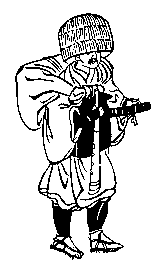
http://www.komuso.com/images/komuso.gif
http://www.komuso.com/images/komuso4.gif
The Photo-Gallery of famous players
http://www.komuso.com/people/photos.html
。。。。。。。。。。。。。。。。。。。。。。。。。。。。。。。。。。。
Shakuhachi, on the following link:
Rooan. The first komusoo
In honor of his shakuhachi (or hitoyogiri), he called himself
Fuuketsu doosha , the Person of the Way of the Wind and Holes.
He also was the founder of the komusoo temple in Kyoto, Myooan-ji or Meian-ji, and the same person also known as Kyoochiku Zenji.
- reference -
.......................................................................

Isoda Koryūsai 磯田湖竜斎 (1735–1790)
Komuso and Beauties
- quote -
The komusō (虚無僧 komusō, hiragana: こむそう; also romanized komusou or komuso)
were a group of Japanese mendicant monks of the Fuke school of Zen Buddhism who flourished during the Edo period of 1600-1868. Komusō were characterized by a straw bascinet (a sedge or reed hood named a tengai or tengui) worn on the head, manifesting the absence of specific ego.[
They were also known for playing solo pieces on the shakuhachi (a type of Japanese bamboo flute). These pieces, called honkyoku ("original pieces"), were played during a meditative practice called suizen, for alms, as a method of attaining enlightenment, and as a healing modality. The Japanese government introduced reforms after the Edo period, abolishing the Fuke sect. Records of the musical repertoire survived, and are being revived in the 21st century
- - - More in the WIKIPEDIA !
. donkorogoma どんころ独楽
Donkoro spinning top for gambling .
It has the images of symbols of good luck to make a bet on.
一富士 Fuji、ニ鷹 Hawk、三なすび/茄子 eggplant、
四だるま Daruma san 五虚無僧 Komuso monk、六西行 poet Saigyo.
Gamblers bet on one side to come up as top and if it does, they get their money back about sixfold.
:::::::::::::::::::::::::::::::::::::::::::::::::::::::::::::::::::::::::::::::::::::::::::::::::::::
The end-blown bamboo flute, the shakuhachi, is another noteworthy solo instrument. It first developed under the influence of Zen priests, with new schools of performance growing up from the 16th to 19th centuries.
http://web-japan.org/museum/music/music.html
http://web-japan.org/museum/music/music01/music01.html
......................................................
Studied Shakuhachi with Izu Hiroshi, master of Tozan school
source : ウベ・ワルタ Uwe Walter
He lives in a little village in the backwoods of Kyoto.
......................................................
quote
History of the Japanese Shakuhachi Flute
The Shakuhachi flute has been traced back as far as ancient Egypt and is thought to have migrated through India and China before being brought back to Japan by monks who were studying abroad in China during the 6th century.
... snip
The Fuke Sect of monks was dissolved around 1871 when the Tokugawa government fell and the Meiji Restoration began. Because of the special arrangement the Fuke Sect had with the Shoguns the Meiji would not honor the Fuke sect in order to weed out and eliminate spies and the Shoguns holdouts. The playing of the shakuhachi became forbidden and its use went underground.
When the Meiji government did permit the use of the shakuhachi again it was played as an accompanying instrument to the shamisen and koto. Many of the honkyoku and important documents were lost during the hiding. It wasn't until 1883 in Kyoto, Japan that the shakuhachi was revived by the Myoan Society at the old Fuke Temple, Myoan-ji. This society is responsible for much of the traditional shakuhachi music we have today.
source : www.zenbambooflutes.com

Elegant Shakuhachi Version of
Ushiwakamaru Serenading Jôruri-hime
奥村政信 Okumura Masanobu (1686–1764)
:::::::::::::::::::::::::::::::::::::::::::::::::::::::::::::::::::::::::::::::::::::::::::::::::::::
Also see my musings about BAMBOO in general,
there are some shakuhachi photos in the Bamboo album
Bamboo Art
Bamboo as a Kigo
My Bamboo Haiku

尺八や 秋の空に響きおり
shakuhachi ya
the sound of autumn
in my valley
GokuRakuAn November 2007
Shakuhachi Concert with Gerhardt Staufenbiel
:::::::::::::::::::::::::::::::::::::::::::::::::::::::::::::::::::::::::::::::::::::::::::::::::::::
From Zen Master Ikkyu (15th century)
The Dreamy Sound
of Bokushitsu's Shakuhachi
Awakened Me from Deep Sleep
One Moonlit Night
A wonderful autumn night, fresh and bright;
Over the echo of music and drums from a
distant village
The single clear tone of a shakuhachi brings a
flood of tears--
Startling me from a deep, melancholy dream.
[from Ikkyu, Zen Master. Wild Ways: Zen Poems of Ikkyu.
Translated and edited by John Stevens. Boston: Shambhala, 1995.]
___
Von Zen Meister Ikkyu (15 Jahrhundert)
Der Verträumte Klang
Von Bokushitsu’s Shakuhachi
Erweckte mich aus tiefem Schlaf
Eine mondhelle Nacht
Eine wunderbare Herbst-Nacht, frisch und hell,
Über dem Echo der Musik und Trommeln aus einem entfernten Dorf
Der einzelne klare Tone der Shakuhachi bringt eine Flut von
Tränen -
Aufgeschreckt bin ich aus einem tiefen, melancholischen Traum.
[von Ikkyu, Zen-Meister. Wilde Wege: Zen-Gedichte von Ikkyu. Übersetzte
und bearbeitete von John Stevens. Boston: Shambhala, 1995.]
…deutsche Übersetzung Mario Trinkhaus
:::::::::::::::::::::::::::::::::::::::::::::::::::::::::::::::::::::::::::::::::::::::::::::::::::::
まづ知るや宜竹が竹に花の雪
mazu shiru ya Gichiku ga take ni hana no yuki
first you must know this !
Gichiku and his bamboo (flute)
bring "snow" to the cherry blossoms
or
first you must know this !
Gichiku and his bamboo (flute)
bring the cherry blossoms to fall like snow
Matsuo Basho
Written in 延宝5年. Basho age 34.
「吉野の山を雪かと見れば、雪ではあらで、や、これの、花の吹雪よの」
The cherry blossoms of Yoshino are famous for "haha no fubuki" cherry blossoms scattering like snow.
Too Saburo 藤三郎 Gichiku 宜竹 (ぎちく)
was a famous Shakuhachi flute player.
Kaijo Shuurin 景徐周麟 (1440 - 1518)
A monk of the Rinzai Sect Musoo 夢窓.
Also called Hanin 半隠, Taishoo 対松.
The shakuhachi at his time was a famous Hitoyogiri 一節切.
One of his famous tunes was "Yoshinoyama".
It was quite a hit in the Edo period and made Basho think of Yoshino.
. Mount Yoshino and more haiku about Gichiku .
. Matsuo Basho 松尾芭蕉 - Archives of the WKD .
:::::::::::::::::::::::::::::::::::::::::::::::::::::::::::::::::::::::::::::::::::::::::::::::::::::
© Two Haiga by Emile Molhuysen, Delft, 2007


:::::::::::::::::::::::::::::::::::::::::::::::::::::::::::::::::::::::::::::::::::::::::::::::::::::
不動尊竹で吹きたり手向けかな
fudouson take de fukitari tamuke kana
in Fudo Myo-O's sanctum,
blowing bamboo as an offering
(bamboo, as in shakuhachi flute)
natsu no hi take to kaeru no duetto kana
summer's day- a duet of frog and shakuhachi!
kunpuu ni ukabu shakuhachi no oto kana
floating on the summer wind, the sound of shakuhachi
Glenn Swann (chikukai)
(my own haiku and translation)
http://www.myspace.com/glennswannshakuhachi
http://shakuhachiflute.blogspot.com/
Translating Haiku Forum, August 2009
Glenn lives near asama yama, close to a fudo-son waterfall in karuizawa called sengataki.
:::::::::::::::::::::::::::::::::::::::::::::::::::::::::::::::::::::::::::::::::::::::::::::::::::::
***** . komusoobana 虚無僧花 "komuso monk flower" .
Lamium album. white nettle
. Fue 笛 Flute playing Daruma
:::::::::::::::::::::::::::::::::::::::::::::::::::::::::::::::::::::::::::::::::::::::::::::::::::::
. komusoo 虚無僧 説 Komuso legends about begging monks .

source and more komuso monsters : togetter.com/li
お猪口が變化した小さな虚無僧のような姿をした妖怪
little monster wearing a 猪口 Sake cup as Komuso hat.
:::::::::::::::::::::::::::::::::::::::::::::::::::::::::::::::::::::::::::::::::::::::::::::::::::::
[ . BACK to WORLDKIGO TOP . ]
[ . BACK to DARUMA MUSEUM TOP . ]
- #komuso #shakuhachi -
:::::::::::::::::::::::::::::::::::::::::::::::::::::::::::::::::::::::::::::::::::::::::::::::::::::
